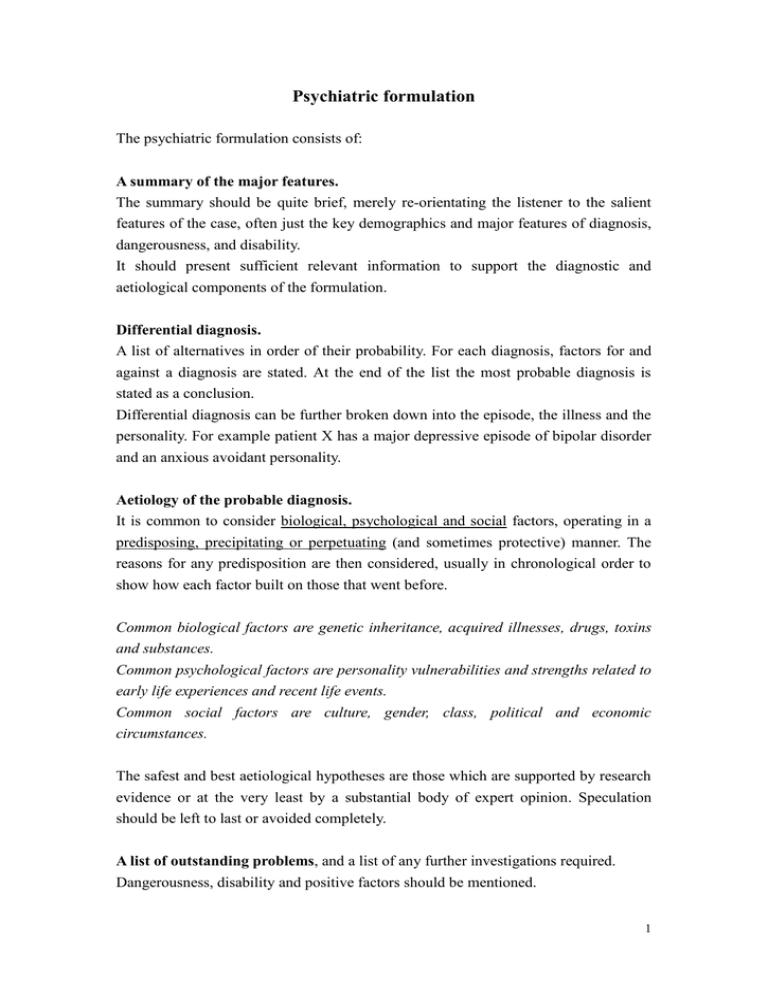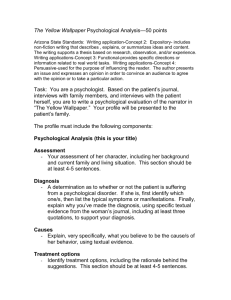Psychiatric formulation
advertisement

Psychiatric formulation The psychiatric formulation consists of: A summary of the major features. The summary should be quite brief, merely re-orientating the listener to the salient features of the case, often just the key demographics and major features of diagnosis, dangerousness, and disability. It should present sufficient relevant information to support the diagnostic and aetiological components of the formulation. Differential diagnosis. A list of alternatives in order of their probability. For each diagnosis, factors for and against a diagnosis are stated. At the end of the list the most probable diagnosis is stated as a conclusion. Differential diagnosis can be further broken down into the episode, the illness and the personality. For example patient X has a major depressive episode of bipolar disorder and an anxious avoidant personality. Aetiology of the probable diagnosis. It is common to consider biological, psychological and social factors, operating in a predisposing, precipitating or perpetuating (and sometimes protective) manner. The reasons for any predisposition are then considered, usually in chronological order to show how each factor built on those that went before. Common biological factors are genetic inheritance, acquired illnesses, drugs, toxins and substances. Common psychological factors are personality vulnerabilities and strengths related to early life experiences and recent life events. Common social factors are culture, gender, class, political and economic circumstances. The safest and best aetiological hypotheses are those which are supported by research evidence or at the very least by a substantial body of expert opinion. Speculation should be left to last or avoided completely. A list of outstanding problems, and a list of any further investigations required. Dangerousness, disability and positive factors should be mentioned. 1 Treatment. A concise plan of treatment is outlined. This should mention social measures as well as psychological treatments and medication, together with the role of nurses and occupational therapists. Prognosis. It is better to make a firm prediction; for example, `These depressive symptoms should recover quickly in hospital but are likely to recur if she stops her medication again.' 口試資料蒐集重點 年齡 求學* 當兵* 家庭* 婚姻* 家族病史 就業* 中輟的原因 主要症狀及其對生活的影響 Screening for psychotic(positive and negative), mood and anxiety symptoms Stressors, Precipitating factors, Coping behavior 身體疾病(頭部外傷 癲癇 甲狀腺, 糖尿病 高血壓 心臟血管疾病) 物質使用 自傷傷人風險 (寧可高估,不要低估) 病程 過去就醫的過程 服藥順從性 治療反應 病識感 支持系統 朋友 休閒 住院幾次 副作用 主要照顧者 復發及住院的主要原因 是否 HEE 是否 burn out 經濟狀況 一天是怎麼過的 MMSE/JOMAC 評估 EPS 未來的計畫 有沒有問題要問醫師 *人際關係 2 面對物質濫用者需注意: 濫用或依賴 intoxication 及 withdrawal 時的身體及精神症狀(psychotic, mood) 精神症狀與物質使用孰先孰後 物質使用之外是否另有精神疾患 勒戒、犯罪紀錄及 personality trait Insight and motivation 面對老人需注意: 身體疾病及其藥物、認知功能(失智或譫妄)、生活自理能力 面對憂鬱的婦女,要問是否停經及月經週期對情緒的影響 年輕憂鬱女子要問是否暴食 Skeme of Formulation 這是一位○歲○婚男性,○○畢業,目前沒有工作 這次住院的主要問題是 患者表示在○歲的時候開始出現○○症狀,開始看精神科 對人際關係造成負面的影響 因此造成學業(工作)上的表現退步 過去○○年來 住院○次 大多是因為 有無 free interval (有無 rapid cycling) 自述是否規則就醫及服藥 (住院頻率高 服藥順從性值得懷疑) 是否仍有殘餘症狀 最近因○○問題而住院 其他個人史的部分 在身體疾病方面 在物質使用方面 患者除了在社交場合偶爾飲酒之外 否認其他成癮物質的使用 在家族史方面 精神疾病史 目前與○○同住 主要照顧者是 在自傷傷人方面 3 精神狀態檢查的部分 患者的外觀還算整齊 (身材胖瘦),意識清醒,態度合作,注意力可以集中, Affect ○○ (是否適切,是否與會談內容及情境吻合),言談切題,行為 思考 delusions, Schneider's first-rank symptoms, formal thought disorder ( paralogical thinking, loosening of association) 意念飛躍 誇大意念; 低自尊 無望 無價值 罪惡感 自殺意念 perception intellectual functions 病識感 判斷 定向感 記憶 抽象思考 計算 診斷 第一軸 但須排除○○ (一定要有鑑別診斷!) Psychological factor affecting general medical condition Neuroleptics-induced Parkinsonism 第二軸 第三軸 第四軸 第五軸 (60 (50 (40 (30 (20 在會談中並沒有發現到有發展遲緩或是人格違常的問題 沒有特別的身體疾病 沒有特別的心理社會壓力 整體功能評估 症狀輕微 社會職業功能並未受到顯著影響) 有相當程度的症狀 社會職業功能在某一領域上受到顯著影響) 症狀明顯 社會職業功能在許多領域上受到顯著影響) 專注於自傷意念 沉浸於症狀 幾乎失去社會職業功能) 最近仍有自傷傷人行為) 治療計畫的部分 (量身訂作 在人身安全方面 以預防復發為主軸) (自傷傷人的風險仍高 必須繼續住院 小心防範) (自傷傷人的風險並不高 維持病房一般的照顧及防護即可) 在生理層面, (檢查甲狀腺功能 排除 organic 的原因) 身體疾病的控制 營養狀態的評估與矯正 在藥物治療方面 目前以○○治療 是否仍有殘餘症狀 有○○副作用 須考慮調整劑量 並給予○○紓解副作用 4 如果要換藥 藥物的選擇 劑型 應留意○○副作用 如何確實給藥 定期監測 在心理層面, 建議安排心理衡鑒 進一步確認其認知功能退化的程度 在衛教方面 患者的病識感仍然不足 須加強患者對疾病的認識 使其了解持續服藥的重要 並教導患者如何分辨復發的早期症狀及如何尋求援助 強化改變的動機 由於患者面臨○○ 因此必須給予 support 並教導其在面臨壓力及挫折時應該 如何紓解與調適 教導如何避免刺激與壓力 建議安排人際互動團體 及社交技巧的訓練 心理治療 放鬆訓練 生理回饋 睡眠衛教 認知行為治療 在社會層面, 澄清誤會 化解先前的人際糾紛或衝突 加強家屬對疾病的認識 以便協助患者服藥與就醫 教導家屬如何與患者相處互動 避免採取批判指責的態度 避免給予患者過度的期待或壓力 家人互動問題 Family intervention 經濟困難、家暴、是否 burn out 轉介社工做進一步的評估 通報 在復健方面 以生活作息的規律為初步的目標 焦點互助團體 建議安排職能評估 依據其手功能、持續力及興趣 來安排適當的活動或工作訓 練 可繼續參與目前在日間留院的工作訓練 加強持續力及工作表現 以便將來有 機會到外面找工作 預後方面不利的因素包括 有利的因素包括 整體來說 值得我們積極給予協助 幫忙患者回歸家庭與社會 5




